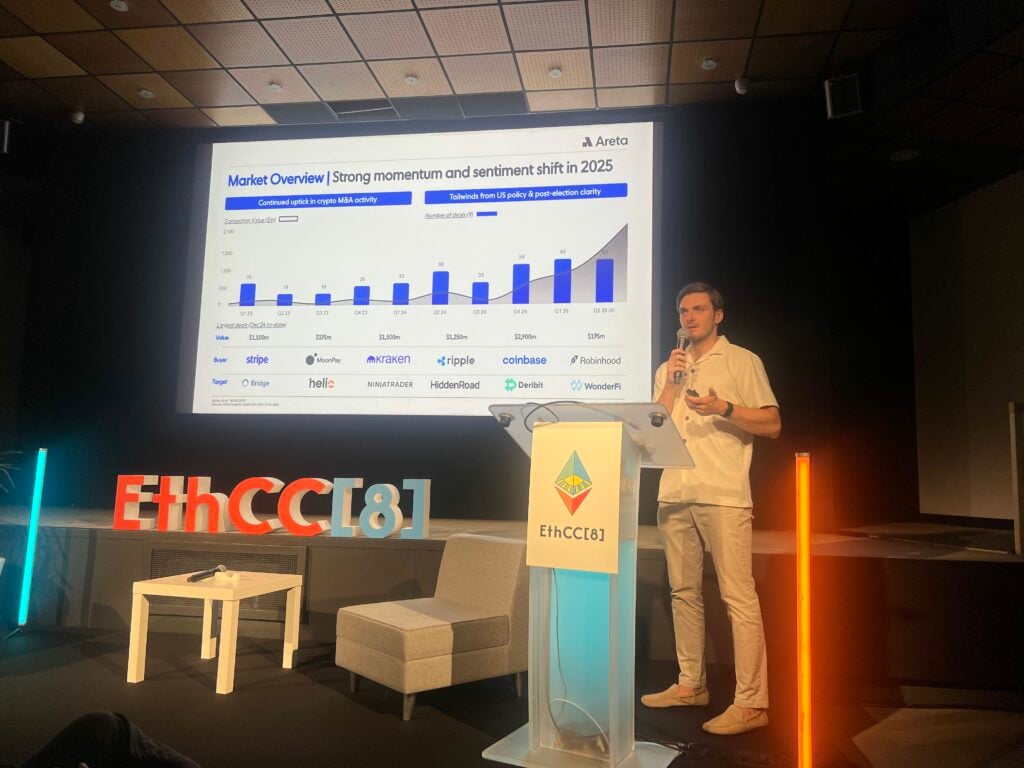
With over 40 billion-dollar deals closed this year, crypto mergers have surged past anything the market has seen before. Areta co-founders trace the forces pushing institutional buyers to pick “buy” over “build” at a record pace.
At a June 30 conference session during ETHCC 8, Areta co-founders Karl-Martin Ahrend and Jan-Philip Grabs walked attendees through what they described as the most active year in crypto M&A history.
Drawing from their advisory work with major players including Robinhood, Swift, and MoonPay, the duo outlined the seismic shift driving 2025’s unprecedented M&A boom, revealing how regulatory clarity and institutional FOMO have turned acquisitions into crypto’s dominant growth strategy.
The numbers speak for themselves: this year’s deal volume has already eclipsed all previous years combined, with trading infrastructure, staking, payments, and on-chain deals leading the charge.

The four fronts driving crypto’s acquisition frenzy
The breakneck pace of crypto M&A isn’t accidental. Behind the 40+ billion-dollar deals of 2025 lie four strategic battlegrounds where acquirers are fighting for dominance:
Trading platforms have become prime targets, not for retail user bases, but for regulatory licenses and institutional infrastructure. When Robinhood acquired Bitstamp earlier this year, insiders saw it as a regulatory power play.
The acquisition gave Robinhood instant access to dozens of jurisdictions and a turnkey institutional trading desk. Similar moves by Coinbase and Swift reflect a new reality: compliance capabilities are now the competitive moat in crypto’s regulated future.
“You’ve seen Robinhood acquiring Bitstamp to increase their licensing footprint around the globe and also add institutional trading capabilities.” Karl-Martin Ahrend noted. Swift has acquired AZ crypto… to obviously consolidate user numbers and create significant synergies between the two businesses.”
The quiet consolidation in staking services tells another part of the story. As proof-of-stake networks now secure the majority of crypto’s value, control over validation operations has emerged as a strategic imperative.
Firms like Source Strategies are absorbing smaller validators, such as Solana-native players, to bring key operations in-house. The goal across the board is vertical control, faster deployment, and future-proofing in an increasingly competitive arena.
At the same time, payment processors are racing to own the entire stablecoin value chain, from issuance to settlement. Stripe’s acquisition of Preview and MoonPay’s European shopping spree reveal a clear pattern: companies are internalizing every step of crypto payments to capture this booming market.
With nearly 80% of crypto businesses now using stablecoins for B2B transactions, these moves represent bets on crypto’s future as a mainstream payment rail rather than just a speculative asset.
Perhaps the most radical development is unfolding transparently on blockchain ledgers themselves. The rise of token-based acquisitions, like Enzyme’s all-token purchase of Microfinance, shows how decentralized organizations are rewriting the M&A playbook.
But as Areta’s Jan-Philip Grabs noted during the presentation, “Unlike in more traditional M&A deals… you’re really lacking the clear framework and processes.” These on-chain mergers face unique challenges, from community governance hurdles to untested legal ground, yet they point toward a future where blockchain-native dealmaking becomes commonplace.

Source link

